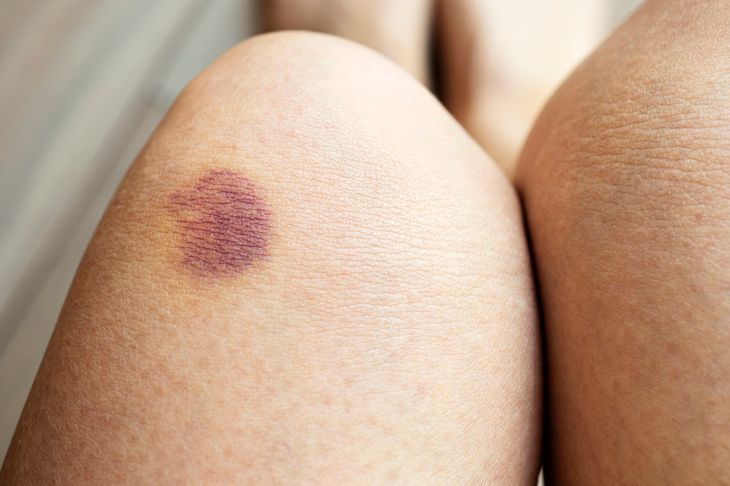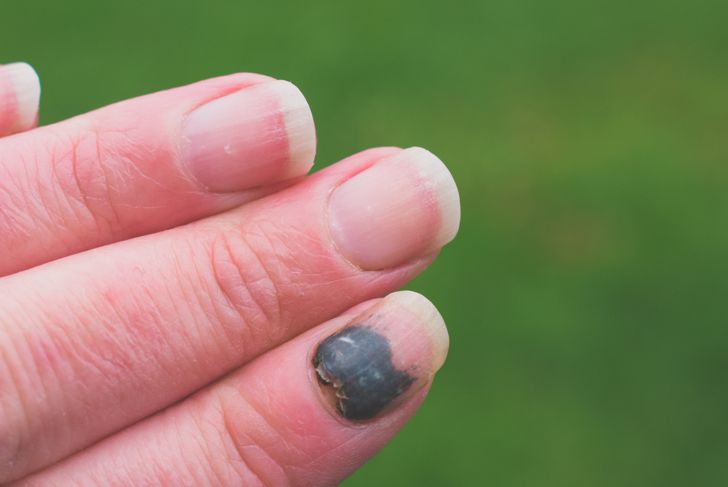A hematoma is pooling blood outside the blood vessels that causes pain, discoloration, and swelling. They look similar to bruises but much more severe — they’re larger and deeper, and they swell due to fluid building up in the area.Where a hematoma develops in the body determines how significant it is and whether immediate treatment is necessary.
Causes
The most common cause of hematoma is trauma from events like motor vehicle accidents and falls. Other factors, such as liver disease, blood thinners, and other medications, can increase bleeding risks and make hematomas more likely and more severe when the trauma occurs.Hematomas can be spontaneous, though this is rare and an indication of more serious underlying medical issues.
Subdermal Hematoma
A subdermal hematoma appears when blood pools under the skin, but the skin remains intact. They can develop anywhere on the body that sustains an injury.These hematomas show up immediately after an injury or a few days later, and they’re easy to spot. In addition to a noticeable purplish-red discolored area under the skin, other symptoms include swelling, tenderness, and pain.
Intramuscular Hematoma
Injury to skeletal muscles can also result in hematomas. Doctors classify muscle injuries as mild, moderate, and severe. Moderate or grade II injuries many develop palpable hematomas within two to three days.The worst type, grade III injuries, involves severe pain, muscle rupture, and extensive hematoma. In these cases, surgery may be necessary if the injury is severe enough. The surgeon will drain the hematoma and make other surgical corrections to the muscle and surrounding tendons and ligaments.
Intracranial Hematoma
Intracranial hematomas form from head injuries. The type depends on where the blood accumulates. Epidural hematomas form between the skull and the outer layer of the meninges, the protective tissue lining the brain. Subdural hematomas form within the layers of this protective tissue, and intracerebral hematomas form within the brain tissue itself.Intracranial hematomas can be life-threatening because they put pressure on the brain, which can cause significant neurological damage.
Septal Hematomas
Septal hematomas usually result from nasal trauma, whether a sports injury, fall, assault, or car accident, and can happen even if the injury is not very severe. Blood collects in the part of the nose between the nostrils.When this kind of hematoma develops in infants and toddlers without other injury, doctors often suspect abuse. They are also common after nasal surgeries.
Subungual Hematomas
Bleeding under the nailbed leads to subungual hematomas, which cause pain and discoloration. This damage typically results from a crush or blow injury to the finger, such as getting a finger stuck in a door.In many cases, subungual hematomas resolve on their own. Sometimes, the blood building up under the nail causes severe pain and requires trephination: the doctor makes a small hole in the nail to relieve the pressure.
Abdominal Hematomas
Abdominal hematomas occur when there is bleeding inside the abdominal muscles. They are most often seen in the rectus muscle layer that stretches from the top of the pubic bone to the sternum.In severe cases, this type of hematoma can spread to the sides of the rectus muscle or into the abdomen. Abdominal hematomas usually result from trauma, but abdominal surgery or over-stressing the muscle can also cause them.
Diagnosis
Diagnosis depends on the location of the hematoma. For subdermal or intramuscular hematomas, the doctor may do an x-ray to check for bone fractures or run labs to test for vitamin deficiencies or clotting disorders.Ultrasound is the test of choice for abdominal hematomas , though a CT may be needed for additional evaluation. For intracranial hematomas, diagnosis typically includes CT scans, MRIs, and angiograms to visualize the blood flow in the brain and determine the extent of the damage.
Treatment
Treatment depends on the location and severity of the hematoma. Small hematomas that produce no other symptoms do not require treatment in many cases. Abdominal hematomas may require embolization or surgical intervention to stop any active bleeding. If the bleeding stops on its own, though, treatment usually focuses on managing symptoms and monitoring for recurrence instead of draining the hematoma.Doctors monitor intracranial hematomas closely. If they are small and produce no neurological symptoms, doctors usually do not remove them. Symptoms can take days to appear, and they can worsen quickly. If severe enough, people with intracranial hematomas can require surgical drainage or brain surgery.
Prevention and Prognosis
To lower the risk of getting a hematoma from an accident or injury, keep living spaces clear of tripping hazards and wear protective gear, like a helmet and pads, when riding a bike or motorcycle or playing contact sports.Most rectus hematomas in the abdomen are non-life threatening, self-limiting, and treated successfully with minimal interventions. For subdural hematomas in the brain, prognosis depends on the severity of the injury, the age of the person, and how quickly they sought treatment. About half of people with large subdural hematomas survive, but they are at high risk of having permanent brain damage.

 Home
Home Health
Health Diet & Nutrition
Diet & Nutrition Living Well
Living Well More
More




















